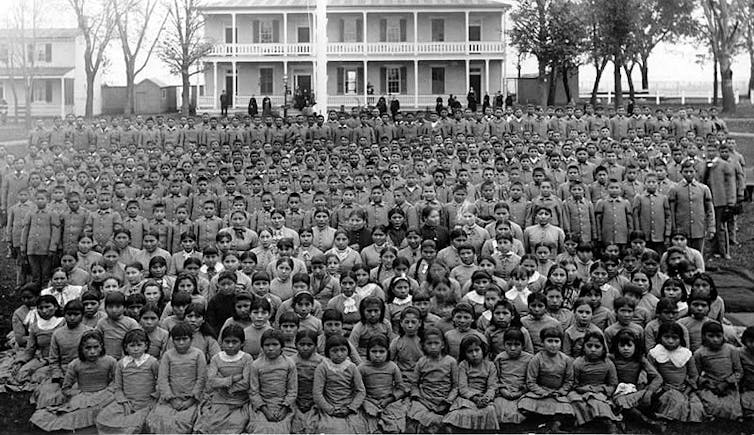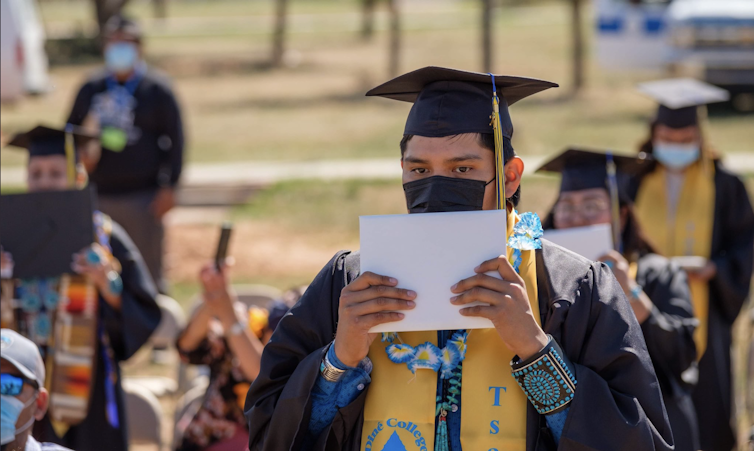Tribal colleges empower Native students with an affordable, culturally relevant education – but need more funding
- Written by Susan C. Faircloth, Professor & Director, Colorado State University
As an American Indian and first-generation college graduate, I know how difficult it can be to successfully navigate higher education.
For me, going to college meant leaving my family, my community, my tribe and all that I knew. Few people on my campus looked or sounded like me. I struggled financially. I was scared, alone and far from home. Many times, I thought of leaving.
But what if I had been given the opportunity to remain in my community and experience a culturally relevant education that reflected Native values, beliefs and ways of doing and being?
As a former director of policy analysis and research at the American Indian Higher Education Consortium[1], a national organization that advocates for Tribal Colleges and Universities (TCUs), I saw firsthand the lasting impacts[2] these colleges make on the educational, cultural, physical and economic well-being of tribes and their citizens.
As Cheryl Crazy Bull, president and CEO of the American Indian College Fund, put it[3], tribal colleges provide a “restorative” education that offers “access to language, socialization, relationships and Indigenous knowledge that is inherently empowering to students and their families.”
The first tribal college
TCUs emerged in the 1960s during the self-determination era[4], in which Native Americans sought greater autonomy and self-governance.
The self-determination movement also sought to end assimilationist policies enforced by the federal government in its effort to “civilize[5]” Native peoples.
It wasn’t until I was pursuing my doctoral degree in education at Penn State University that I really understood the extent to which American Indians and Alaska Natives fought to shape their own education. It was a right that had been long denied by education policies that aimed to “kill the Indian … and save the man[6],” as described by the founder of Carlisle Indian Industrial School, a boarding school for Native students, in 1892.
 Students at Carlisle Indian Industrial School in Pennsylvania circa 1900.
Students at Carlisle Indian Industrial School in Pennsylvania circa 1900.
The fight for self-determination led to increased educational opportunities for Native peoples at all levels.
The first tribal college, Navajo Community College, now known as Diné College[7], was established in 1968 by the Navajo Nation. Located on the Navajo Reservation in Tsaile, Arizona, the college provided culturally relevant, geographically accessible and affordable higher education to members of the Navajo Nation from Arizona, New Mexico and Utah.
Tribal colleges grow
In 1971, Congress passed the Navajo Community College Act[8]. The legislation provided funding for the school, which had previously been financed[9] by the Bureau of Indian Affairs under the 1921 Snyder Act[10], also known as the Indian Citizenship Act.
Several years later, in 1978, the Tribally Controlled Community College Assistance Act[11] was passed, paving the way for new tribal colleges. It defined TCUs as institutions of higher education that are “formally sanctioned, or chartered, by the governing body of an Indian tribe or tribes” and serve a majority of students who are American Indian or Alaska Native.
Schools that met those criteria could receive federal funds based on the number of American Indian and Alaska Native students enrolled.
In addition to the TCUs authorized under these acts, the Bureau of Indian Education[12], within the U.S. Department of the Interior, operates and funds three additional tribal colleges. These institutions – Haskell Indian Nations University[13] in Kansas and Southwest Indian Polytechnic Institute[14] and the Institute of American Indian Arts[15] in New Mexico – serve students from tribes located across the U.S.
Supporting whole communities
Today, about 40 TCUs are spread across 16 states[16].
Nearly 17,000 students[17] – approximately 80%[18] of whom are American Indian or Alaska Native – attend these schools each year. In addition to degree programs, TCUs offer an array of nondegree programs and services such as childcare, GED preparation, health care, job training, economic development, and language and cultural programming.
TCUs provide pathways to higher education that many Native students would not otherwise have due to geographic isolation, family and community responsibilities and poverty[19]. A 2019 survey[20] of students from seven tribal colleges found high rates of food and housing insecurity[21] compared to their peers at other types of colleges and universities.
To offset their students’ financial needs, TCUs try to keep tuition rates low – less than US$3,000 per year[22] on average.
The American Indian College Fund[23], established by tribal college presidents in 1989, also provides scholarships and awards to eligible students, as well as a range of programs[24] in collaboration with the TCUs. These include grants and initiatives for teaching early childhood education[25], preserving Indigenous cultures and languages[26], addressing environmental issues[27] and building new infrastructure[28] within the colleges.
Chronic underfunding
However, more than 50 years after the establishment of Navajo Community College, TCUs remain chronically underfunded[29]. This is due, in large part, to a federal formula that determines funding based on the number of American Indian or Alaska Native students they enroll, rather than the total student enrollment.
Although TCUs were established to serve the academic and cultural needs of Native peoples, many enroll significant numbers of non-Native students. Approximately 21%[30] of TCU students were non-Native in the 2018-19 school year.
Failure to provide funding for non-Native students places an additional financial burden on these institutions. On top of that, TCUs receive little or no[31] local or state funding for core operations. The result is often poorly maintained[32] housing, classrooms, libraries, laboratories and other facilities.
President Biden’s pledge[33] to increase financial support for minority-serving institutions, including TCUs, is much-needed.
 Diné College commencement in May 2021 in Tsaile, Arizona.
Courtesy of Diné College, CC BY-NC-ND[34][35]
Diné College commencement in May 2021 in Tsaile, Arizona.
Courtesy of Diné College, CC BY-NC-ND[34][35]
‘Trust responsibility’
TCUs have a unique relationship with the federal government that is grounded in the government’s trust responsibility[36] for Native peoples.
This trust responsibility is a legal obligation to provide for the education, health and welfare of federally recognized tribes and their members. It is based on treaties entered into between the federal government and tribal nations between the 1770s and 1870s[37].
[Get the best of The Conversation, every weekend. Sign up for our weekly newsletter[38].]
As was evident with the establishment of the first tribal college in 1968, the future of tribes and tribal citizens is closely linked to their access to affordable, culturally relevant, community-based and adequately resourced education. In the words of Sherry Allison, president of Southwestern Indian Polytechnic Institute, tribal colleges are “stewards of opportunities[39] to steer our Native nations in a direction that fosters well-being and survival.”
The federal government has a legal, political and – I believe – moral obligation to ensure TCUs not only survive, but thrive.
References
- ^ American Indian Higher Education Consortium (www.aihec.org)
- ^ lasting impacts (repository.upenn.edu)
- ^ put it (www.ccsse.org)
- ^ self-determination era (www.proquest.com)
- ^ civilize (files.eric.ed.gov)
- ^ kill the Indian … and save the man (carlisleindian.dickinson.edu)
- ^ Diné College (www.dinecollege.edu)
- ^ Navajo Community College Act (www.govinfo.gov)
- ^ previously been financed (tribalcollegejournal.org)
- ^ Snyder Act (www.aps.edu)
- ^ Tribally Controlled Community College Assistance Act (www.aihec.org)
- ^ Bureau of Indian Education (www.bia.gov)
- ^ Haskell Indian Nations University (www.haskell.edu)
- ^ Southwest Indian Polytechnic Institute (www.sipi.edu)
- ^ Institute of American Indian Arts (iaia.edu)
- ^ across 16 states (www.aihec.org)
- ^ 17,000 students (nces.ed.gov)
- ^ approximately 80% (nces.ed.gov)
- ^ poverty (www.pewresearch.org)
- ^ 2019 survey (hope4college.com)
- ^ food and housing insecurity (theconversation.com)
- ^ less than US$3,000 per year (cmsi.gse.rutgers.edu)
- ^ American Indian College Fund (collegefund.org)
- ^ range of programs (collegefund.org)
- ^ early childhood education (collegefund.org)
- ^ Indigenous cultures and languages (collegefund.org)
- ^ environmental issues (collegefund.org)
- ^ new infrastructure (collegefund.org)
- ^ chronically underfunded (www.aihec.org)
- ^ Approximately 21% (nces.ed.gov)
- ^ little or no (www.luminafoundation.org)
- ^ poorly maintained (aihec.org)
- ^ President Biden’s pledge (www.whitehouse.gov)
- ^ Courtesy of Diné College (twitter.com)
- ^ CC BY-NC-ND (creativecommons.org)
- ^ trust responsibility (www.bia.gov)
- ^ 1770s and 1870s (www.americanindianmagazine.org)
- ^ Sign up for our weekly newsletter (theconversation.com)
- ^ stewards of opportunities (tribalcollegejournal.org)
Authors: Susan C. Faircloth, Professor & Director, Colorado State University

